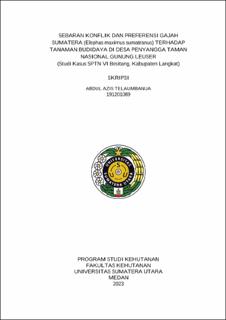| dc.description.abstract | The Sumatran elephant (Elephas maximus sumatranus) is the largest herbivore found in Sumatra. This animal is regarded as endangered according to Regulation P.20 / MENLHK / SETJEN / KUM.1 / 6 / 2018 of the Minister of Environment and Forestry of the Republic of Indonesia. Human-elephant conflict (HEC) allegedly occurred in a number of these buffer villages, according to the Sumatra Hijau Lestari Foundation (YSHL). In 2022, the neighborhood experienced up to 8 incidents related to conflict. Through roaming observation and the collecting of census data on attitudes, this study was conducted in the VI TNGL communities of Bukit Mas Village, Mekar Makmur Lepan, and Sei Serdang Village. 48 KGM distribution stations were found in the Sumatran home range. In RBI 2012, HEC scored the highest (35 points) for the sort of forest land cover that was turned into plantations. At elevations ranging from 0 to 1100 meters above sea level, 48 conflict spots were located. There were 15 points of contention on a grade of 0–8% (flat), 26 on a slope of 8–15% (sloping), 4 on a class of 15–25% (very steep), and 3 on a class of 25–40% (severe). 46 points of contention were located between 0 and 1000 meters from the river, while 2 locations were located between 1000 and 2000 meters. It was noted that the community in KGM-prone locations grew 34 different kinds of plants. based on findings from observations of 12 different cultivars of plants consumed by elephants | en_US |


